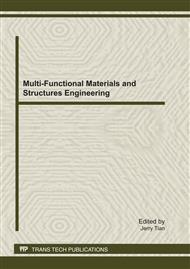[1]
Y. G. Wang, X. Zhu, W. S. Xiang, et al: Green transportation planning and regional sustainable development within metropolitan regions: the role of traffic pollutant inventory in decision making. International Journal of the Physical Sciences Vol. 6 (2011).
Google Scholar
[2]
Y.G. Wang, K.M. Chen, L.W. Hu, et al: Voluntary killer: multivariate highway geometric factors contributing to crashes and collisions in China's mountainous regions. Technics Technologies Education Management – TTEM Vol. 5 (2010), p.531–543.
Google Scholar
[3]
F. Bella, G. D'Agostini: Combined effect of traffic and geometrics on rear-end collision risk: Driving simulator study. Transportation Research Record 2165 (2010), p.96–103.
DOI: 10.3141/2165-11
Google Scholar
[4]
D.J. Kim, K.H. Park, Z. Bien: Hierarchical longitudinal controller for rear-end collision avoidance. IEEE Transactions on Industrial Electronics Vol. 54 (2007), p.805–817.
DOI: 10.1109/tie.2007.891660
Google Scholar
[5]
C.Y. Chang, Y.R. Chou: Development of fuzzy-based bus rear-end collision warning thresholds using a driving simulator. IEEE Transactions on Intelligent Transportation Systems Vol. 10 (2009), p.360–365.
DOI: 10.1109/tits.2009.2020204
Google Scholar
[6]
Y.G. Wang, H. Bai, W.S. Xiang: Traffic safety performance assessment and multivariate treatments for intersection locations. The Baltic Journal of Road and Bridge Engineering Vol. 6 (2011), p.30–38.
DOI: 10.3846/bjrbe.2011.05
Google Scholar
[7]
Y.G. Wang, K.M. Chen, Y.L. Pei, et al: Integrating before and after crash features into measuring the effectiveness of intersection safety improvement project in Harbin. Transport Vol. 26 (2011), p.111–120.
DOI: 10.3846/16484142.2011.565599
Google Scholar
[8]
Y. Deng, F. F.T.S. Chan: A new fuzzy dempster MCDM method and its application in supplier selection. Expert Systems with Applications Vol. 38 (2011), p.9854–9861.
DOI: 10.1016/j.eswa.2011.02.017
Google Scholar
[9]
A. Bentrcia, A. Zerguine, M. Benyoucef: A new chip-level linear BSOR-GSIC multi-user detector for long-code CDMA systems. The Arabian Journal for Science and Engineering Vol. 34 (2009), p.447–459.
DOI: 10.1155/2007/25945
Google Scholar
[10]
E. Alghonaim, A. El-Maleh, M. A. Landolsi, et al: A platform for LDPC code design and performance evaluation. The Arabian Journal for Science and Engineering Vol. 35 (2010), p.135–152.
Google Scholar


